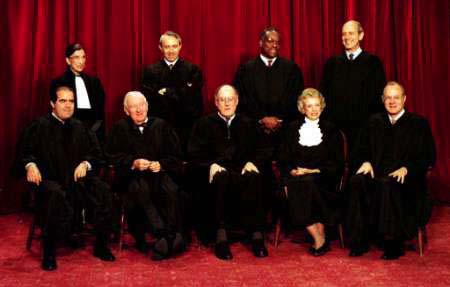Supreme Court of the United States
From dKosopedia
Categories: Supreme Court of the United States | Judiciary of the United States
The Supreme Court of the United States, located in Washington, DC, is the highest court in the United States; that is, it has ultimate judicial authority within the United States to interpret and decide questions of federal law. It is head of the judicial branch of the United States Government. The other two branches of the United States Government are the executive branch and the legislative branch.
The Supreme Court is sometimes known by the acronym SCOTUS.
top row l-r: Ruth Bader Ginsburg, David Souter, Clarence Thomas, Steven Breyer
bottom row l-r: Antonin Scalia,, John Paul Stevens, William Rhenquist, Sandra Day O'Connor, Anthony Kennedy
Contents |
Overview and Analysis
As of January 31, 2006, members of the Supreme Court include George W. Bush appointees Chief Justice John G. Roberts, Jr. and Samuel A. Alito, Jr.; Ford appointee John Paul Stevens; Reagan appointees Antonin Scalia, and Anthony Kennedy; Bush (I) appointees David Souter and Clarence Thomas; and Clinton appointees Ruth Bader Ginsburg and Stephen Breyer.
Before 2006, there were three main voting blocs on the Court. The liberals, consisting of Ginsburg, Stevens, Souter, and Breyer; the center-right bloc (O'Connor and Kennedy); and the Conservative bloc (Rehnquist, Scalia, and Thomas). Chief Justice Roberts and Associate Justice Alito are widely expected to vote with the Conservative block, threatening to shift the court to a reliably conservative majority.
The Conservatives and the center-right bloc often formed a 5 vote majority to defeat the liberals. O'Connor was often the decisive vote, defecting to the liberals or staying with the conservatives. In a recent case, Kyllo v. United States, 533 U.S. 27 (2001) (per Scalia, J.; dissent by Stevens, J.) the blocs were scrambled, as they frequently are on issues before the Court where the usual partisan leanings do not provide clear guidance. The majority consisted of Scalia, Souter, Thomas, Ginsburg, and Breyer; the dissenters were Rehnquist, Stevens, O'Connor, and Kennedy.
The Supreme Court is defined in Article III of the Constitution. The Supreme Court issues a writ of certiorari on the vote of four of its justices to hear a case. In some rare instances, the Supreme Court has "original jurisdiction" (e.g. cases between states) and, therefore, does not act as an "appeals" court.
There have been seventeen Chief Justices, or "Courts," in the Supreme Court's history. It was under Chief Justice John Marshall that the Court first exercised the revolutionary power of Judicial Review to invalidate a law passed by Congress as unconstitutional.
Though political preference is arguably the best predicter of how an individual justice will vote in many cases, often-times the justice's method of constitutional or statutory interpretation plays the most significant role. For example, Justice Scalia was the author of Oncale v. Sundowner Offshore Service, 523 US 75 (1998), in which the Court held that men can sue their employers for sexual harassment by other men at work. Justice Scalia explained that the plain language of the statute (Title VII) required such a result. The problem, of course, is that many cases heard by the Supreme Court are not so clear-cut.
Upcoming Cases
List of important upcoming cases for the Supreme Court.
Chief Justices
There have been 17 Chief Justices of the United States,
Former Associate Justices
| Name | Years of Service | Appointed by President |
|---|---|---|
| Sandra Day O'Connor | 1981-2006 | Ronald Reagan |
Recent Nominations
The makeup of the U.S. Supreme Court is hanging in the balance. The late Chief Justice Rehnquist was replaced by John G. Roberts Jr., and the President will now nominate a successor to Justice O'Connor who has submitted a resignation effective upon the appointment of a successor.
O'Connor is the swing vote in the nine member Court, assuming that Roberts is more conservative in his jurisprudence than O'Connor, which almost all observers expect will be the case. Thus, while the Roberts appointment kept the partisan balance in tact, the O'Connor replacement will likely decisively affect the balance of power in the Court. A moderate appointment would become the new swing vote on the Court. An appointee more conservative than Justice Kennedy (which is the kind of nominee most people expect George W. Bush to put forward), would make Justice Kennedy the swing vote on most partisan issues in the Court.
To replace O'Connor, Bush nominated Harriet Miers, who withdrew because of opposition from social conservatives. Bush then nominaed Samuel A. Alito, Jr. on October 31, 2005. He was confirmed on January 31, 2006.
Related Articles
- Supreme Court of the United States


![[Main Page]](../../../../upload/banner-blue-135.jpg)